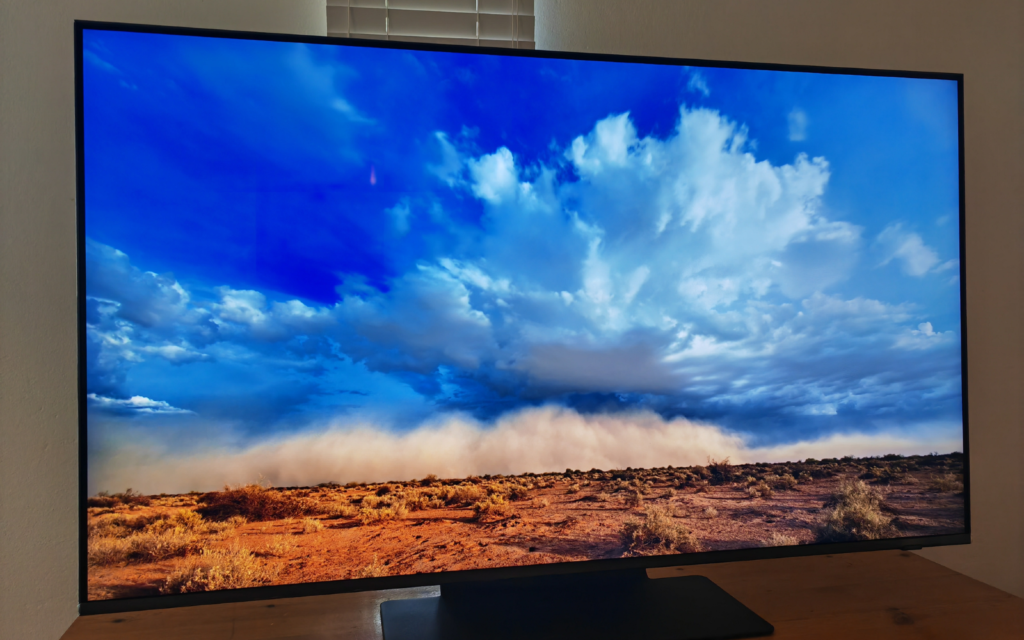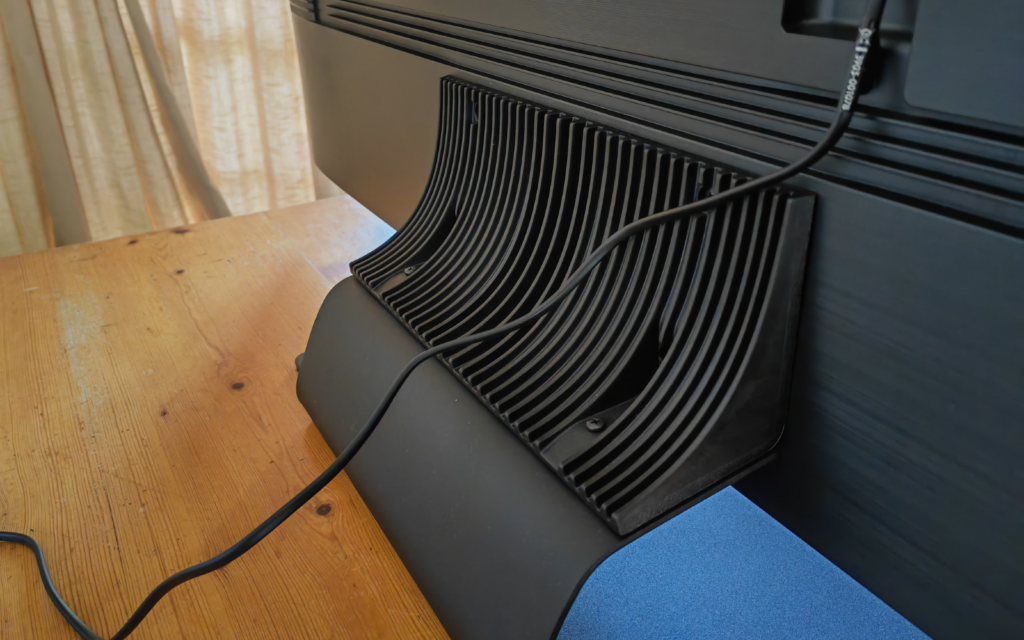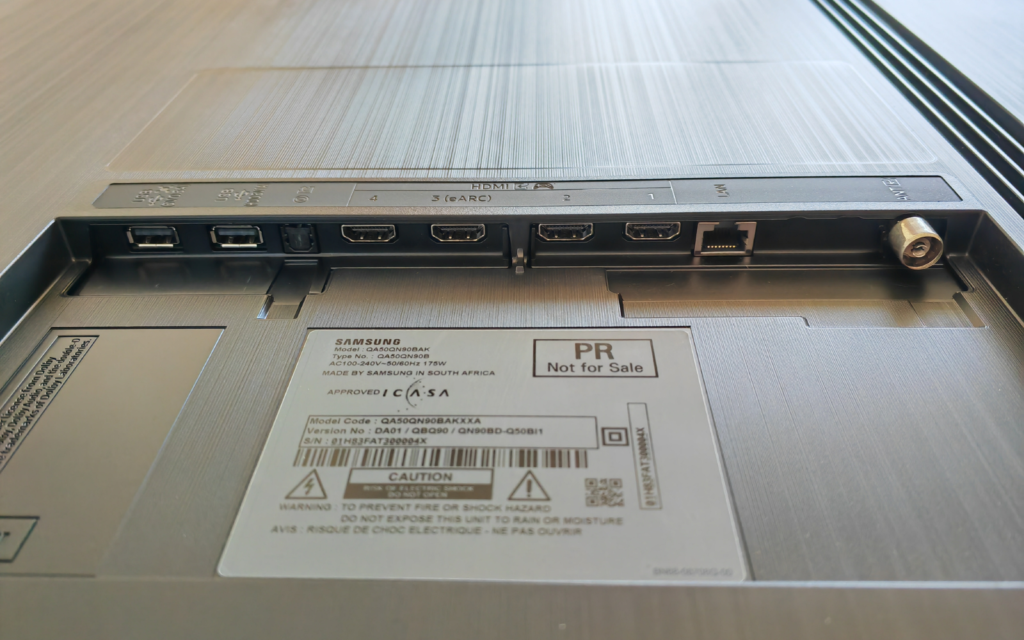You can't go wrong with the QN90B unless you're specifically after OLED performance (or Dolby Vision support). It deserves a place on every TV shortlist, thanks to its versatility and stupendous gaming performance.
-
Design
-
Display
-
Performance
-
Price
-
Features
If you’ve been a reader of Stuff Magazine (at least for the previous three issues), you would’ve seen Samsung’s QN90A appear at the top of our Top 10 TVs list. Heck, we even named it our TV of the Year for 2021. Earlier this year at CES, Samsung unveiled its QN90B series. With that, it was looking to improve on what came before. We’ve spent a bit of time with the 50in QN90B and we are mightily impressed. We’re not sure how Samsung has managed to cram these smarts into a package this competitively priced. Actually, we do know, but we’re getting to that.
This is Samsung’s second go with its Neo QLED TVs. That’s just the company’s fancy name for TVs with the mini-LED tech it pioneered at the beginning of last year. Although they contain some of the same letters, mini-LED and OLED are different. Those differences are important to understand when looking for a new TV.
Mini-LED vs OLED
OLED TVs still provide a much better viewing experience in terms of colour accuracy and contrast. Each pixel is self-illuminating, meaning there isn’t a big back-light behind them, and each pixel can turn on and off independently. One of the drawbacks is OLEDs don’t get all that bright. They’re more suited to an environment where you have control over the ambient light.
Mini-LED TVs still use an LCD panel but the number of LEDs is now in the tens of thousands. They’re grouped into local dimming zones which give greater control over brightness and contrast accuracy. It’s not as skillful as OLED, though. But it does mean the panels get a lot brighter. These are perfect for a TV in a living room where you aren’t only consuming media and you maybe don’t have as much control over light levels. Mini-LED TVs also tend to be a bit cheaper than OLED TVs.
Samsung offers this particular TV in a few sizes. The smaller 43in and 50in models are slightly different from the 55, 65, 75, 85, and 98in models. The smaller sets do up to 144Hz for a start (more on that later), have a different screen coating for diffusing light and have fewer speakers. We had the 50in model so that’s what we’re basing this review on.
We just want the numbers, Mason
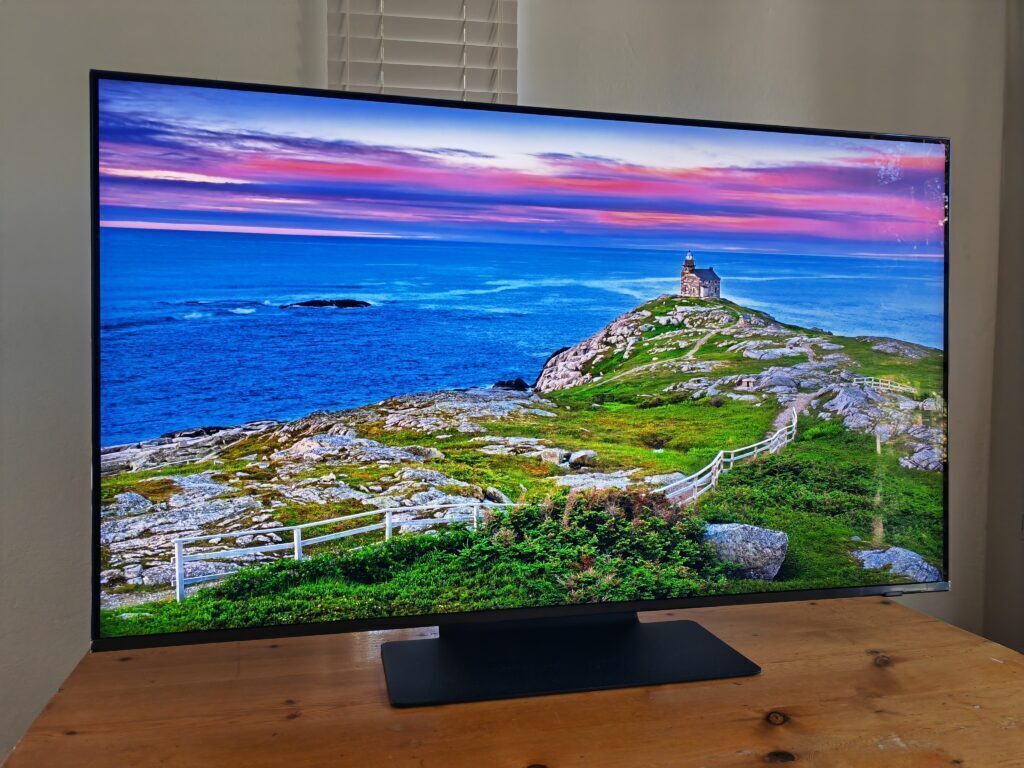 In terms of performance, the QN90B does very well. It gets plenty bright enough with SDR and HDR content at all times of the day. Even in a well-lit room at midday, colours appear punchy but not overly saturated. It is even a little too bright in a completely dark room at max brightness. Of course, there are a host of picture settings and presets for you to play with to achieve the image you want. There’s also a smart feature that’ll adjust brightness based on the ambient light the sensor picks up.
In terms of performance, the QN90B does very well. It gets plenty bright enough with SDR and HDR content at all times of the day. Even in a well-lit room at midday, colours appear punchy but not overly saturated. It is even a little too bright in a completely dark room at max brightness. Of course, there are a host of picture settings and presets for you to play with to achieve the image you want. There’s also a smart feature that’ll adjust brightness based on the ambient light the sensor picks up.
Expect good local dimming control which translates to great contrast levels. Not OLED-great, but still great. This is still an LCD-based TV so you do get some blooming around bright objects in dark scenes. It’s not terrible, and you can’t have everything at this price point.
Two other niggles we had on our unit were some Dirty Screen Effect (DSE) and a bit of stutter on slow panning shots. DSE is caused by inconsistent luminance performance across the surface area of the panel. This usually presents itself as random splotches, wide bars, uniform lines, or vignetting.
This is most noticeable in scenes or content with large areas of the same colour. In golf, for example, there’s usually lots of grass on the screen or if you’re using the TV as a PC monitor you’ll see it in a Windows Explorer window.
This particular problem is prevalent to varying extents with almost all LCD-based TVs and monitors. It comes down to what’s known as the ‘panel lottery’ and the manufacturer’s quality testing tolerances. Sometimes you’re lucky and get a good one. Other people might not be so lucky.
Unless you catch it early and send it back within the return period there isn’t much you can do about it. Once you see DSE on your TV you can’t unsee it and there is no way to consistently fix it. With that in mind, if you want to test your set, use this video. Don’t say we didn’t warn you.
Do you want to play a game?
The stuttering is thanks to this TV’s excellent pixel response times. There are some motion smoothing settings to fiddle with if it gets too much for you. If you plan to play any games on this TV, you’re in for a treat. The 4K panel has a native refresh rate of 120Hz and supports Variable Refresh Rates with the Xbox Series X and PlayStation 5. If you plug in a gaming PC you can get up to 144Hz, providing your PC can manage it.
That’s only available on the two smaller models (48in and 50in) though and you’ll need to switch the TV into Game Mode for this. But that can adversely affect the local dimming and brightness as it appears the TV is favouring low pixel response and input latency. Speaking of which, we didn’t notice any input lag whatsoever.
Another impressive feature, and something TV shoppers tend to overlook, are the viewing angles. Only one or two lucky people in the house are going to be sitting directly in front of the TV. The rest will be off to either side. Mostly, positioning won’t matter. Unless you’re staring directly at the side, you’re going to be impressed with the colour accuracy and contrast.
You’ll find support for most of the content you’re trying to watch. Unless it uses Dolby Vision. Samsung TVs don’t generally offer support for Dolby Vision or the DTS audio format. This is presumably to save on certification and licensing fees. If you’re a Dolby stan then you’ll have to look elsewhere. But we highly doubt you’ll be able to find a 50in TV packing these smarts for the same price.
Flip it over
Around the back of the TV, you’ll find holes you can use to mount this thing if you don’t want to use the stand. You’ll also find four HDMI 2.1 ports, one of which supports eARC, two USB-A ports, and an optical port. If you do opt to mount it we’d recommend plugging in your sources first, as they’re set a little into the TV.
The included stand is heavier than it looks, which was reassuring. But it’s centre mounted which means the TV has a little bit of wobble, which isn’t very reassuring. But, after some deliberate table shaking and simulated gusts of wind, we were tired and the TV was still standing. We can’t speak to the effects of dogs or large children, though.
The back of the TV and stand contains grooves, presumably making cable routing easier. It’s a nice thought but doesn’t really work in practice as there’s nothing to keep the cables in the grooves. That said, the TV does look rather handsome with the stand and thin bezels. Like a monitor that’s all grown up.
TizenOS gets an update
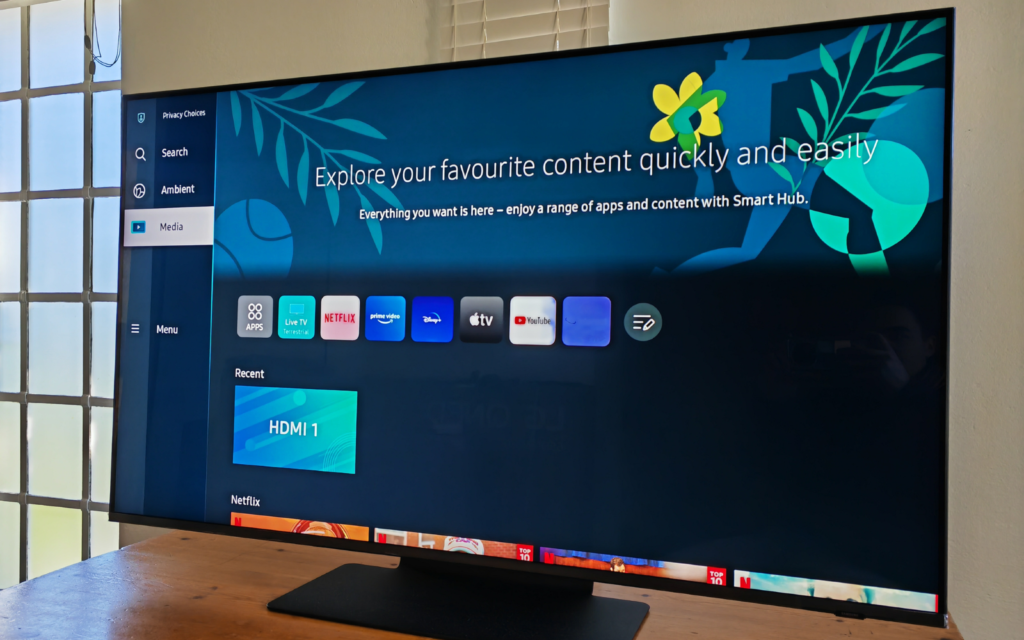 If you’ve used a Samsung smart TV running TizenOS you’re in for a bit of a surprise. The OS has had a facelift. Instead of the bar along the bottom, you now get a fullscreen hub, similar to LG’s WebOS. Except it isn’t as slick. There’s a bit too much clicking to get to commonly used settings like choosing your source or changing the picture settings.
If you’ve used a Samsung smart TV running TizenOS you’re in for a bit of a surprise. The OS has had a facelift. Instead of the bar along the bottom, you now get a fullscreen hub, similar to LG’s WebOS. Except it isn’t as slick. There’s a bit too much clicking to get to commonly used settings like choosing your source or changing the picture settings.
Samsung has also implemented a smart calibration function that’ll let you calibrate your TV using a compatible smartphone camera. It’s a nice feature but we didn’t really notice a difference between the out-of-the-box settings and the basic calibration. The advanced calibration changed even less.
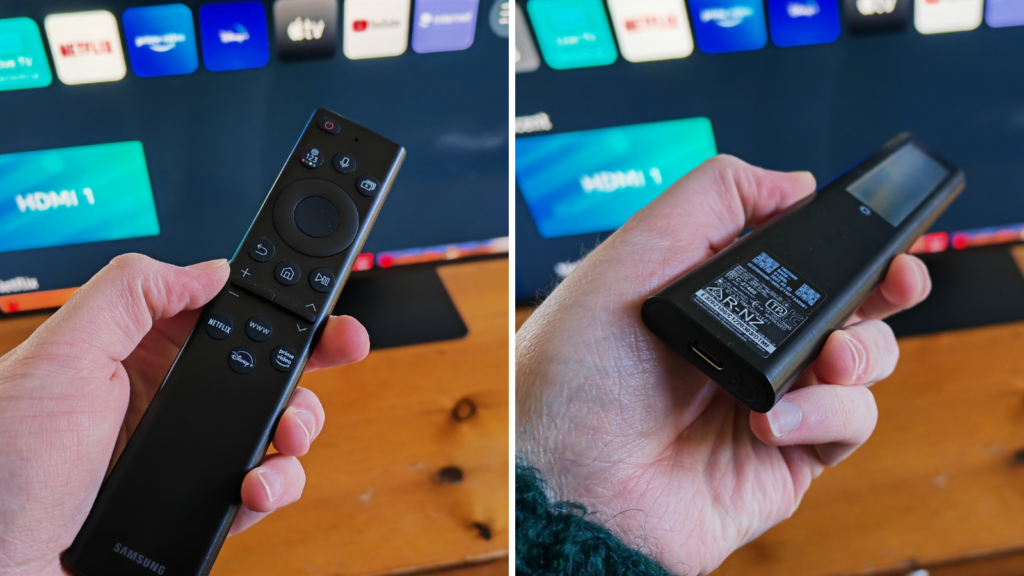 The QN90B comes with Samsung’s solar cell remote, named because it features a solar cell with which it will charge itself if you leave it underside up. It apparently also uses radio frequencies to charge but that sounds a little… sci-fi. It’s’ also impossible to test. Samsung assures us that it works, though. If it does eventually die, you can also resort to USB-C charging. A remapping feature would’ve been nice here. Maybe that would’ve saved us some clicking.
The QN90B comes with Samsung’s solar cell remote, named because it features a solar cell with which it will charge itself if you leave it underside up. It apparently also uses radio frequencies to charge but that sounds a little… sci-fi. It’s’ also impossible to test. Samsung assures us that it works, though. If it does eventually die, you can also resort to USB-C charging. A remapping feature would’ve been nice here. Maybe that would’ve saved us some clicking.
Samsung 50QN90B verdict
You can’t really go wrong with this TV. If you’re looking to replace your set ASAP so you don’t miss the rugby (which looks fantastic, btw), this one should be on your shortlist. If you’re planning to hook up a console or PC to your TV, this goes on the shortlist for that too. For cinephiles looking to build a home theatre, the lack of Dolby Vision might be harder to overlook. All the negatives we’ve mentioned (minus the DSE and lack of Dolby Vision) can be overcome. There isn’t much more you can ask for from a TV. Possibly to save humanity from Agent Smith and his clones? Can we have that?

